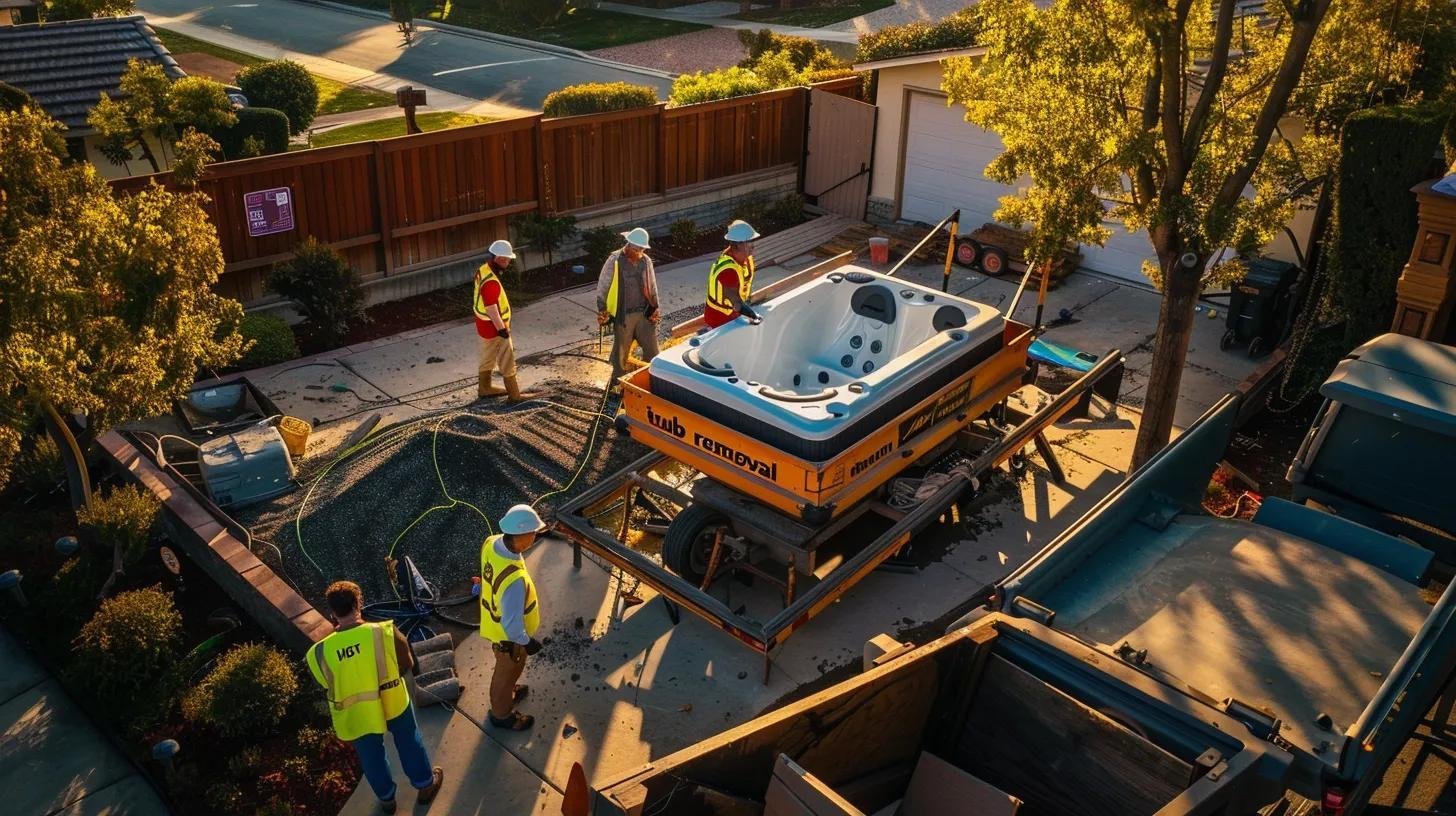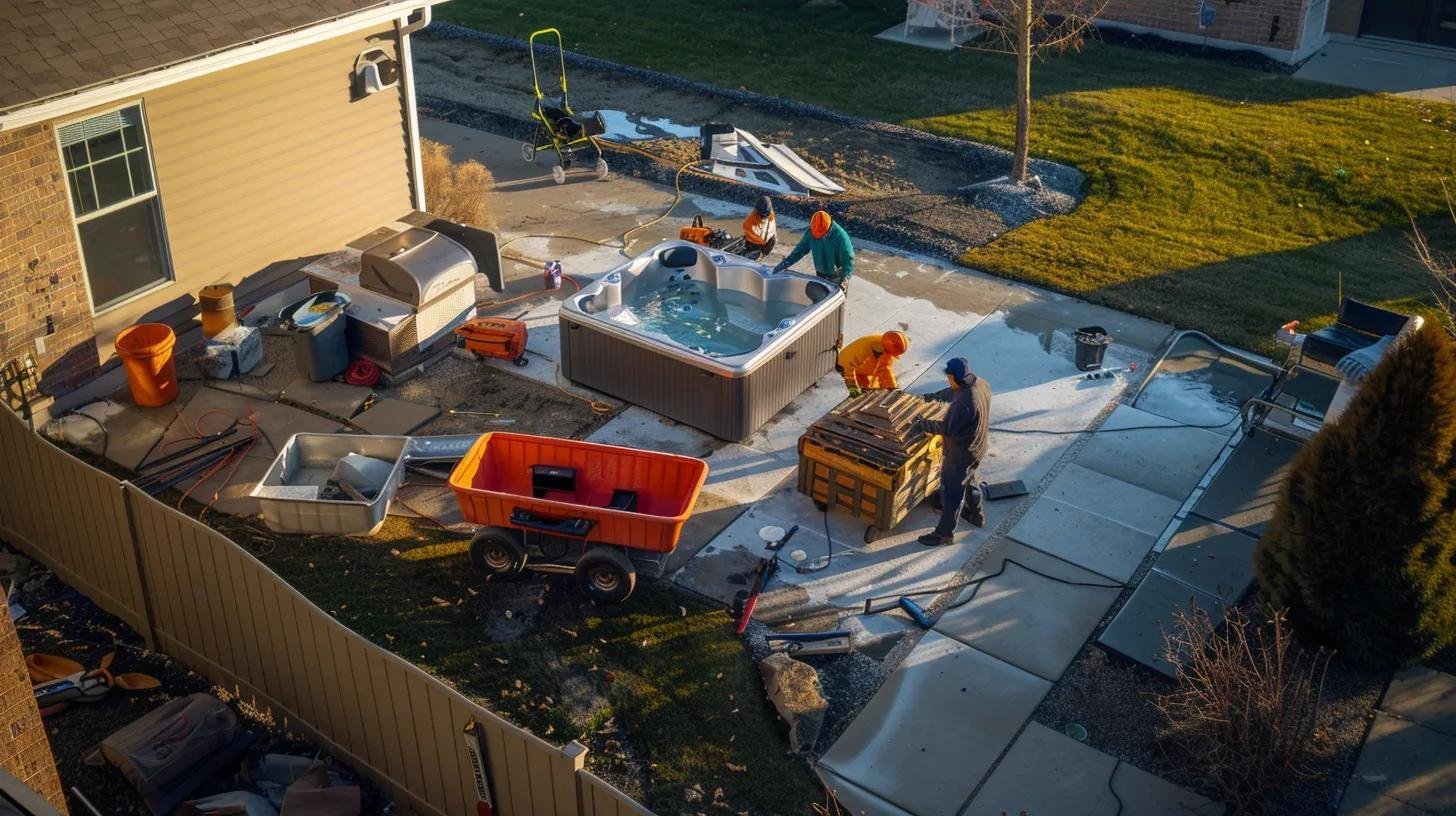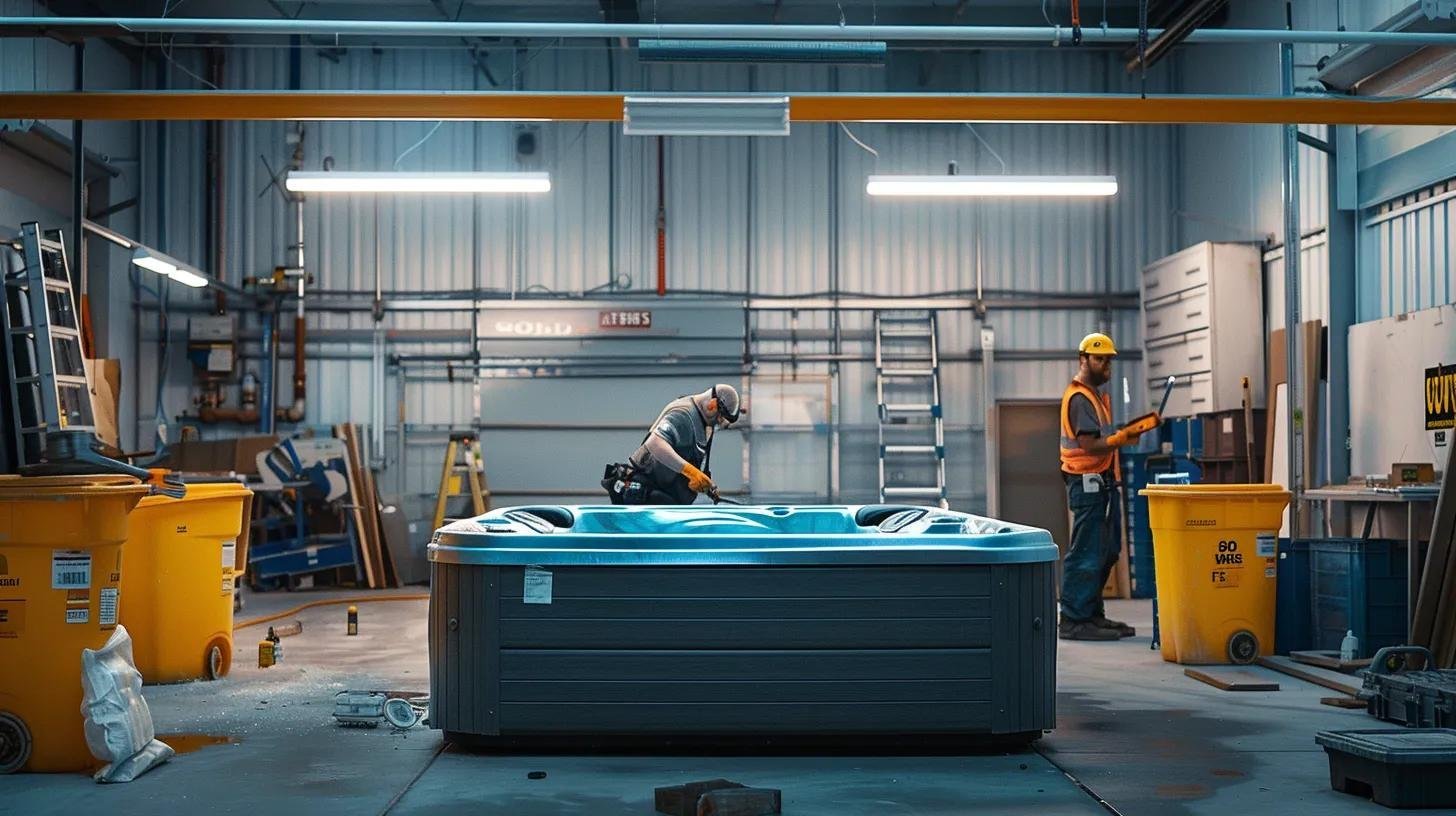Hot Tub Removal Costs & Risks: Professional vs DIY Tips
Removing a hot tub can be a daunting undertaking for homeowners. Often, the process involves hidden expenses and safety risks, making it essential to fully understand the costs and potential dangers before making a decision. This article explains the financial considerations, risks, and valuable steps you can take to mitigate both expenses and hazards associated with professional and DIY hot tub removal. Homeowners seeking to remove their hot tubs will gain insights into identifying appropriate service providers and reducing costs while ensuring safe disposal practices.
Key Takeaways
- Professional hot tub removal involves standard fees as well as additional charges based on accessibility and type.
- There are inherent risks such as physical injuries, property damage, and environmental hazards.
- DIY removal may save money but carries significant safety risks and additional costs for tools.
- Homeowners can reduce expenses by preparing the site and verifying service credentials.
What Are the Potential Costs Involved in Professional Hot Tub Removal?

Professional hot tub removal costs vary depending on the service provider and the specific conditions of your installation. The process is typically priced based on both a flat rate and additional factors such as the hot tub’s location, size, and dismantling complexity. hot tub removal
Standard Service Fees for Hot Tub Haul Away
Providers charge a base fee for the standard hauling away of a hot tub removal. This fee typically covers the removal process, transportation, and basic disposal costs. It is usually set at a fixed amount, which may vary by region. Typical fees might range between $200 to $500.
Additional Charges Homeowners Might Encounter
Extra charges could include fees for dismantling built-in hot tubs, hoisting a heavy unit from difficult-to-access areas, or special disposal fees if hazardous materials are present. Moreover, some companies charge more for urgent services or if your property is in a congested or high-demand area.
How Hot Tub Size and Type Impact Removal Price
The size, weight, and type (freestanding vs. built-in) influence the overall removal cost. Larger units require more labor, specialized equipment, and sometimes additional permits for disposal. The material composition—whether metal, fiberglass, or plastic—also affects pricing due to differing recycling and disposal costs.
Obtaining Accurate Quotes From Removal Specialists
It is essential to contact several reputable removal services to compare detailed estimates. Accurate quotes should list all potential additional fees and conditions. Homeowners should ask if the fee includes
, cleanup, and transportation to an approved disposal facility.
Understanding What Is Included in a Professional Removal Quote
A thorough quote should break down labor costs, equipment fees, transportation, disposal, and any additional surcharges. A clear understanding helps avoid surprise expenses on the day of removal. Homeowners are advised to verify if the quote covers cleanup of debris and removal of residual waste from the property.
Identifying the Potential Risks Associated With Hot Tub Disassembly and Disposal

Hot tub removal is accompanied by several risks that homeowners should carefully consider. These risks are not only limited to physical injuries but also include damage to the property and environmental hazards.
Common Physical Injury Hazards During Removal
Working with heavy, bulky equipment and awkwardly positioned units can lead to strains, back injuries, or accidental cuts. Improper lifting techniques or sudden moves might result in injuries when the hot tub removal is disassembled.
Risk of Damage to Your Property or Landscaping
Removing a hot tub can put your flooring, walls, or landscaping at risk. Equipment like cranes or heavy-duty vehicles used during removal might inadvertently damage the deck, patio, or surrounding areas if not handled carefully.
Electrical and Plumbing Dangers to Be Aware Of
Disconnecting power and water supply involves electrical and plumbing work, creating potential hazards such as electric shock or leaks. It is crucial to switch off circuit breakers and follow proper safety protocols before initiating any action.
Environmental Concerns From Improper Spa Disposal
Disposal of hot tub components containing oils, chemicals, or retrofitted metal parts must be executed according to local guidelines. Improper disposal can lead to contamination of soil or water and may incur legal repercussions.
Liability Issues Homeowners Should Consider
Homeowners may be held liable for any accidents or damages incurred during removal if proper permits and professional services are not utilized. Ensuring that removal professionals carry adequate insurance can help mitigate these risks.
Factors That Determine Your Hot Tub Removal Expenses

Several factors affect the overall cost of hot tub removal, making it important to assess your situation carefully before proceeding with either professional or DIY methods.
The Role of Hot Tub Accessibility in Pricing
Accessibility is a critical factor; units situated in tight spaces or on higher levels typically require more effort, specialized gear, or even structural modifications. Easy access reduces labor time and overall costs significantly.
Material Composition and Its Effect on Disposal Costs
The construction of your hot tub, whether it is made of fiberglass, metal, or plastic, determines the method of disposal. Metals might be recycled at a lower cost while fiberglass could require specialized disposal processes.
Geographic Location and Local Disposal Regulations
Local laws and disposal regulations can lead to local pricing variations. Some regions mandate additional fees for hazardous waste disposal or require permits, thereby increasing the service cost.
Is Your Hot Tub Freestanding or Built-In?
Freestanding hot tubs are generally easier to remove than those that are integrated into decks or patios. Built-in hot tubs often require additional demolition and restoration work, affecting the final price.
Condition of the Hot Tub and Required Demolition Effort
A deteriorated or corroded hot tub may require extra effort for dismantling. The amount of demolition work, including cutting or breaking apart the unit, can increase removal expenses due to the increased labor and tool requirements. For help with hot tub removal, contact us.
DIY Hot Tub Removal: Assessing the Financial Savings Versus Potential Dangers
A do-it-yourself approach can sometimes offer cost savings, yet the potential dangers and hidden expenses can outweigh the benefits if not executed properly.
Calculating Tool Rental and Material Expenses for DIY
DIY removal may involve the rental of heavy-duty tools such as a reciprocating saw, power drill, or even a mini-crane. These costs, along with the price for safety gear, can add up, sometimes approaching or exceeding professional service fees.
Time Investment Required for a Do-It-Yourself Approach
Homeowners need to invest significant time, planning, and labor into a DIY removal project. The effort required may disrupt daily routines, especially if additional help is not available.
Safety Equipment Needed for a DIY Hot Tub Removal
Essential safety gear, such as gloves, hard hats, safety goggles, and steel-toed boots, is required to prevent injuries. Skipping proper precautions can lead to serious accidents and medical expenses.
Potential for Unexpected Problems and Added DIY Costs
Unexpected complications, such as structural damage to the surrounding area or hidden electrical issues, may arise. These can lead to additional time and financial costs far beyond initial estimates.
When DIY Is Feasible Versus When to Call Professionals
DIY might work for easily accessible, freestanding hot tubs in good condition. For built-in units, complex disassembly, or locations with special hot tub removal regulations, hiring professionals ensures safety and compliance.
Ensuring Safe and Environmentally Sound Hot Tub Disposal Practices
Responsible hot tub disposal is vital to ensure that you do not harm the environment or incur legal issues. Homeowners must use approved methods and facilities for proper disposal.
Locating Approved Landfills or Recycling Centers
Research local waste management facilities to find those that accept large items like hot tubs. Approved recycling centers are equipped to process various materials in an environmentally friendly manner.
Understanding Local Ordinances for Large Item Disposal
Familiarize yourself with local laws regarding bulk trash removal and hazardous waste. This helps in avoiding fines and ensures that the disposal method complies with regulations.
Options for Recycling Hot Tub Components
Recycling parts such as metal frames, plumbing, and electronic components may lower disposal fees. Some removal services collaborate with recycling centers to properly process these components. Removal services may help with this.
Avoiding Fines Through Compliant Disposal Methods
Using a reputable removal service that follows local guidelines will help you avoid fines. Check that each service provider has the necessary licenses and permits.
Eco-Friendly Alternatives for Old Hot Tub Materials
Consider recycling or repurposing materials from the old hot tub. Some companies transform waste into raw materials for home improvement projects, thereby reducing cost and minimizing environmental impact.
Steps Homeowners Can Take to Reduce Removal Costs and Mitigate Risks
There are proactive steps homeowners can take to ease the financial burden and reduce safety risks during hot tub removal. Preparation and clear communication with service providers are key.
Preparing the Area Around the Hot Tub for Easy Access
Clearing the surrounding area of debris, furniture, and other obstacles can expedite removal. A well-prepared site reduces the overall labor required and lowers the risk of accidental damage.
Draining and Disconnecting Utilities Safely Before Removal
Ensure that all water, electrical, and gas connections are properly shut off. This preventive step minimizes the risk of electrical hazards and water damage while the unit is displaced.
Disassembling Parts of the Hot Tub Yourself if Able
Careful removal of detachable components, such as covers or control panels, can simplify the job. However, exercise caution and refer to manufacturer instructions to avoid damage.
Communicating Clearly With Your Chosen Removal Service
Discuss all potential extra charges and details about your hot tub’s condition before the appointment. Clear communication ensures there are no hidden fees and that the process will run smoothly.
Verifying Insurance and Licensing of Removal Professionals
Request proof of insurance and proper licensing to ensure that any accidental damage or injury is covered. This verification protects homeowners from unexpected liabilities and ensures that professionals are qualified for the job.
Final Thoughts
Hot tub removal involves careful planning and significant costs, with several factors influencing the final price. Homeowners should weigh the benefits of professional services against potential DIY savings while being mindful of safety hazards and environmental regulations. Preparation through site clearance and clear communication with certified removal professionals can help mitigate risks and lower expenses. Overall, understanding both the costs and potential risks is vital for a safe, efficient removal process that protects your property and health.
Frequently Asked Questions
Q: What factors primarily determine the cost of hot tub removal? A: Costs depend on accessibility, size and type, material composition, and local regulations, with built-in units generally costing more due to additional hot tub removal work.
Q: Is DIY hot tub removal safe? A: DIY removal may reduce costs but carries risks such as injuries and unexpected complications; proper safety equipment and expertise are essential. For professional help, consider our hot tub removal services.
Q: How can homeowners ensure environmentally friendly disposal? A: By using approved disposal facilities and recyclable methods for hot tub removal components, homeowners can reduce environmental impact and avoid fines.
Q: What steps can reduce removal costs? A: Preparing the removal area, disconnecting utilities safely, and verifying service credentials can all help lower overall costs.
Q: Why is verifying insurance and licensing important for removal services? A: It protects homeowners from potential liabilities and ensures that professionals are qualified to perform the removal safely. removal services
